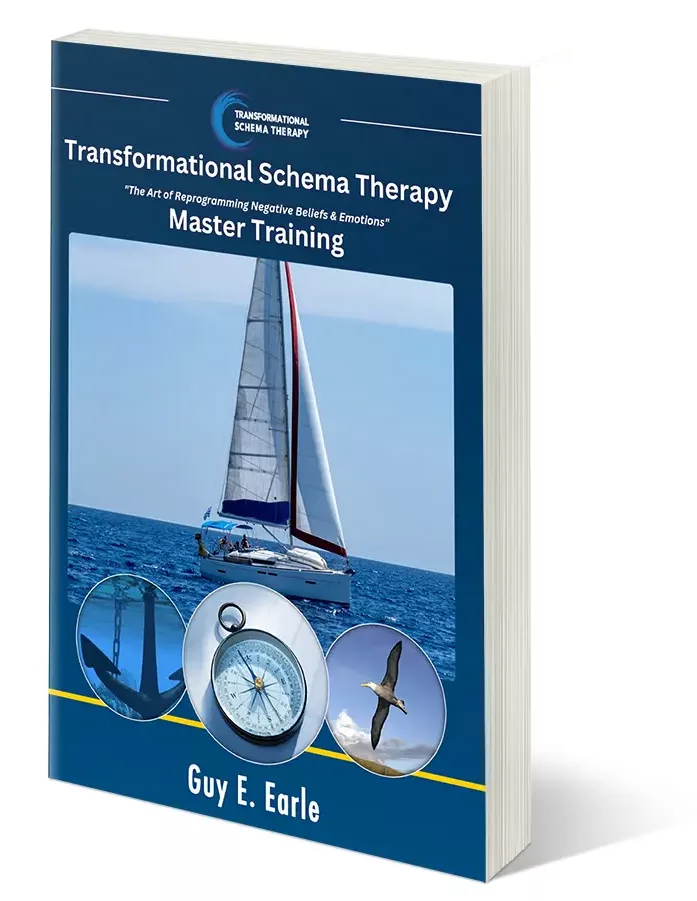TranceFormation– The Art of communicating to the Unconscious Mind
The Iceberg Effect–this originated from Hemingway, who said that only the tip of the iceberg showed in fiction–your reader will see only what is above the water–but the knowledge that you have about your character that never makes it into the story acts as the bulk of the iceberg. And this is what gives your story weight.
Gain the practical processes and knowledge toward the success of Transformational Schema Therapy. Here you receive the tools to refresh, revive and rejuvenate your patient’s collaboration and rapid emotional wellbeing. As the largest scope of the iceberg hides in the depths, so is human activity found in the deeper reservoir of the mind. Learn the process to access past human experiences to breakthrough frozen beliefs toward transformation.

Module 1: The Four Modes of Communication
As a practitioner, gaining insights and lessons on visual communication can significantly enhance your communication skills and effectiveness in working with clients who use a visual mode of communication. Using visual communication with these individuals can be a powerful tool in therapy sessions to convey complex information, express emotions, and facilitate understanding. Visual communication can also help you:
Refresh and gain new practical skills and strategies to enhance their communication, connect with clients more effectively, and promote positive therapeutic outcomes.
As a practitioner, gaining insights on auditory language communication can greatly enhance your communication skills and effectiveness in working with clients who favor auditory communication. Auditory language communicators may rely heavily on verbal communication, tone of voice, and other auditory cues to process information and convey their thoughts and emotions. By understanding their communication style and preferences, you can adapt your communication approach to meet their needs more effectively. Benefits include:
Gain valuable skills to improve communication and connect more effectively with clients who favor auditory communication, leading to more successful therapeutic outcomes.
Module 1:3 – 1:4 explores the limbic system’s role in automatic response
As a practitioner, gaining insights on clients who prefer a kinesthetic communication style can lead to more successful therapeutic outcomes. Kinesthetic language communicators may rely heavily on physical sensations, body language, and movement to express their thoughts, emotions, and experiences. By understanding their communication style and preferences, you can adapt your communication approach to meet their needs more effectively
Review strategies to incorporate physical sensations, gestures, and movement into your therapeutic interactions. By connecting with clients on a deeper kinesthetic level, may provide a more experiential and embodied therapeutic experience for you and your client Additional benefits include:
Auditory digital language communicators may rely heavily on internal self-talk, logical reasoning, and systematic thinking to process information and convey their thoughts and emotions. As a practitioner, by understanding their communication style and preferences, you can adapt your communication approach to meet their needs more effectively.
Through Module 1:4 on auditory digital language communication, you can learn strategies to use clear and precise language, provide logical explanations, and engage in systematic problem-solving discussions with your clients. This can help you build rapport, establish trust, and create a more structured and analytical therapeutic environment.
Understanding auditory digital language communication can improve your ability to interpret and respond to your clients’ logical thought processes and provide information in a way that resonates with their cognitive style. Improving your auditory digital language communication can empower your sessions with valuable skills to improve communication and connect more effectively with clients who prefer an auditory digital communication style, leading to more successful therapeutic outcomes.
Discover proven ways to decode a person’s representational system refers to understanding their preferred mode of sensory perception and information processing, which includes visual, auditory, kinesthetic, and auditory digital (or internal self-talk).
Everyone has a unique communication style, and individuals may use a combination of representational systems depending on the context and situation. It is important to use the mode of communication is a guideline and to always remain flexible in your communication approach to ensure effective communication with your clients.
Favored Representational Systems
The meaningful collaboration of truth and understanding between the Practitioner and Patient. For true collaboration, both practitioner and patient must find a method of trusted communication. Here we are reminded of the importance of of communication and review methods of interpreting communicational systems and to remember that every person has all four representational systems operating to some extent.

Module 2: Identifying a person’s Internal Representation
Module 2:1: Existence: Ask questions to understand how the person mentally represents the concept of existence. For example, you can ask, “What does existence mean to you?”, “How do you know something exists?”, or “How do you represent the concept of existence in your mind?” Pay attention to their language, sensory cues, and any images, sounds, or sensations they associate with the concept of existence.
Module 2:2 : Possibility/Necessity: Inquire about how the person represents the concepts of possibility and necessity in their mind. Ask questions like, “How do you know if something is possible or necessary?”, “What does possibility/necessity look like, sound like, or feel like to you?”, or “How do you represent the difference between possibility and necessity in your mind?”
Module 2:3: Cause & Effect: Explore how the person represents the concept of cause and effect in their internal experience. Ask questions like, “How do you mentally represent cause and effect?”, “What images, sounds, or sensations come to mind when you think of cause and effect?”, or “How do you differentiate between cause and effect in your mind?”
Module 2:4: Complex Equivalence: Inquire about how the person mentally represents the concept of complex equivalence, which involves making connections or associations between different things or events. Ask questions like, “How do you represent complex equivalence in your mind?”, “What do you see, hear, or feel when you make connections between things?”, or “How do you mentally link different concepts or events together?”
Module 2:5 : Awareness: Ask questions to understand how the person represents the concept of awareness in their mind. For example, you can ask, “How do you know when you are aware of something?”, “What is your internal experience when you are fully aware?”, or “What sensations, thoughts, or feelings do you associate with awareness in your mind?”
Module 2:6: Time: Explore how the person represents the concept of time in their internal experience. Ask questions like, “How do you mentally represent time?”, “What images, sounds, or sensations come to mind when you think of time?”, or “How do you perceive the passage of time in your mind?”
Module 2:7: Adjective/Adverb: Inquire about how the person represents adjectives and adverbs, which are descriptive words, in their internal experience. Ask questions like, “How do you mentally represent adjectives and adverbs?”, “What do you see, hear, or feel when you use descriptive words?”, or “How do you differentiate between different adjectives or adverbs in your mind?”
Module. 2:8: Exclusive/Inclusive: Explore how the person represents the concepts of exclusivity and inclusivity in their internal experience. Ask questions like, “How do you mentally represent exclusivity and inclusivity?”, “What images, sounds, or sensations come to mind when you think of exclusivity and inclusivity?”, or “How do you differentiate between exclusive and inclusive concepts in your mind?”
“How do you mentally represent ordinal concepts?”
“What do you see, hear, or feel when you think of rank or order?”
“How do you differentiate between different ordinal concepts in your mind?”
The Art of Connection
Identifying a person’s internal representation in regards to abstract concepts such as existence, possibility/necessity, cause & effect, complex equivalence, awareness, time, adjective/adverb, exclusive/inclusive, and ordinal can be challenging as these concepts are subjective and may vary from person to person. However it is a powerful process to understanding how an individual internally represents or experiences a particular event, thought, memory, or emotion in their mind. This can be done through careful observation, active listening, and asking relevant questions to gather information about the person’s subjective experience.

Module 3: Meta Models
“Everyone always ignores me.” This statement is a distortion as it uses universal quantifiers (“everyone” and “always”) and may not accurately represent the reality of the situation. It’s a generalization that may not be true in all situations.
Module 3:2: Generalization: Generalization involves making broad statements or assumptions based on limited or incomplete information. It’s a way of simplifying and categorizing information to make sense of the world, but it can also lead to inaccurate or biased perceptions. Generalizations often involve the use of words like “always,” “never,” “everyone,” or “nobody.”
Example:
“I failed one test, so I’ll never succeed in anything.” This statement is a generalization as it assumes that one failure in a specific situation will apply to all areas of life, which may not be accurate or helpful.
Module 3:Deletion: Deletion refers to the omission or exclusion of information in communication. It’s a way of filtering out certain details or ignoring certain aspects of reality, which may result in an incomplete or distorted understanding of the situation. Deletion can occur in various forms, such as leaving out relevant details, ignoring contradictory information, or overlooking important nuances.
Example:
“I went to the store, and then… yeah, that’s it.” This statement is a deletion as it omits any details about what happened at the store or any other relevant information, resulting in an incomplete communication.
Anchoring the Emotional Soul
Meta Models are a set of language patterns used in Neuro-Linguistic Programming (NLP) to identify and challenge the structure of a person’s language and beliefs. They involve questioning and clarifying language patterns that may involve distortions, generalizations, and deletions, with the aim of promoting clearer and more accurate communication, challenging unhelpful beliefs, and facilitating effective problem-solving and understanding.
By employing Meta Models in communication, you can aid your client to pinpoint and question detrimental language patterns and beliefs and facilitating a clearer understanding of shifting these negative patterns.

Module 4: The Gold Standard of Communication
In module 4:2: Milton’s Models, a set of language patterns in Neuro-Linguistic Programming (NLP), involve intentionally vague and ambiguous language that allows for multiple interpretations and meanings. These patterns, such as metaphor, analogy, ambiguity, and open-ended questions, are used to create a broader spectrum of understanding, allowing for flexibility in communication and inviting diverse interpretations. Unlike the Meta Models that aim to clarify language, the Milton’s Models encourage a more subjective and flexible approach, providing room for individual interpretation and creative expression in communication.
Untangling Saboteur Schemas
In this Module we look at using language to convey a range of ideas that spans from general to specific can be achieved through deliberate and skillful employment of various linguistic techniques. This can involve using language patterns that allow for multiple interpretations, utilizing metaphors, analogies, and ambiguity, and posing open-ended questions. By employing these techniques, one can effectively communicate in a way that offers flexibility and adaptability in expressing a spectrum of ideas that may encompass both broad generalities and nuanced specifics, catering to the diverse interpretations and understandings of different individuals.

Module 5: Shifting Sub-modalities
Submodalities are the smaller sensory elements that make up our subjective experiences. They are the building blocks of our internal sensory experiences, such as our thoughts, memories, emotions, and perceptions. Sub-modalities refer to the specific sensory qualities or attributes that we associate with our experiences, such as the size, location, brightness, color, volume, and distance of our sensory representations.
In module 4:2 Like to Dislike: We explore shifting sub-modalities from like to dislike as a technique to help individuals change their emotional responses and behaviors towards certain things, such as overcoming cravings or addictions, reducing unwanted habits, or changing attitudes towards certain situations or people.
It involves consciously manipulating the sensory qualities of internal representations to create a different subjective experience and perspective, ultimately influencing one’s emotions, thoughts, and behaviors associated with the targeted object or experience.
Module 5:3: We use the Sub-Modality Checklist tool to identify and explore the various sensory qualities or characteristics of an individual’s internal representations. It consists of a list of sensory modalities, including visual, auditory, kinesthetic, olfactory, and gustatory, along with specific sub-modalities within each modality, such as brightness, size, distance, location, volume, tone, texture, and temperature. The Sub-Modality Checklist is used to help individuals gain awareness of the sensory details that make up their internal experiences and how they are organized in their mind. By identifying and manipulating these sub-modalities, individuals can potentially change their subjective experiences, perceptions, and responses to certain stimuli or situations.
You find new uses for the Sub-Modality Checklist to facilitate personal change, enhance communication, and improve problem-solving skills.
Module 4:3 Swish Patterns: We discuss the Swish Patterns technique in Neuro-Linguistic Programming (NLP) that is used to help individuals shift their cognitive and emotional responses from an undesired state or behavior to a more desired state or behavior.
We review the use of sensory sub-modalities, such as visual and auditory elements, to create a mental pattern that interrupts and replaces an unwanted internal representation with a new, more desirable one. The Swish Pattern technique typically involves visualizing the undesired state or behavior, and then quickly and vividly visualizing the desired state or behavior while using a “swishing” motion in the mind to rapidly replace the unwanted representation with the desired one.
This process is repeated several times as a means to reinforce the new desired state, and can be used to facilitate personal change, enhance motivation, overcome limiting beliefs, and promote more positive and empowering mental patterns.
Our goal is to create lasting change and improving outcomes in various areas of life, including self-improvement, goal attainment, and behavioral change.
Module 5:4: Dissociation Techniques: This refer to a set of methods used to create a psychological separation or detachment from an internal representation or experience. Dissociation involves mentally distancing oneself from a particular experience, thought, or emotion, as if observing it from a third-person perspective, rather than being fully immersed in it.
We discuss the utilization of various dissociation techniques, such as visual dissociation, auditory dissociation, and kinesthetic dissociation, to help individuals gain a new perspective, change their emotional response, or reframe a situation in a more empowering way.
Dissociation techniques can be useful in overcoming negative emotions, reducing the intensity of traumatic memories, gaining clarity and objectivity in problem-solving, and promoting cognitive flexibility. Our goal is to help individuals shift their subjective experiences and responses to certain situations, enabling them to create new possibilities and outcomes for personal growth and change.
Module 5:5: The Secret Sauce to all Transformation:
In this module we pull it all together into a transformative state for your client:
The first step is foster awareness of the problem and identify its symptoms or manifestations. This is done by creating a mental picture or image of the problem. The next step is the dissociation from the problem, creating an emotional barrier or detachment from it, similar to observing a lion behind thick glass at a zoo. This allows the individual to interact with the problem without being emotionally overwhelmed by it.
The next phase involves associating with resources or solutions, which refers to the necessary mindset, emotions, or other elements needed to address the problem effectively. The resources are incorporated into the problematic situation, even if the individual is not consciously aware of the process. Finally, the resources are projected into the future through an emotional vision board, where the individual imagines successfully utilizing the resources to overcome the problem. This process aims to create a positive shift in mindset, emotions, and perspective, leading to desired outcomes and changes in behavior and experience.
Sailing Down Wind “Unconscious Mastery”
In this Module we look at Shifting Sub-Modalities. In this we are referring to the process of consciously changing or manipulating the sensory qualities of one’s internal representations in the mind. Sub-Modalities are the finer details or characteristics of the sensory experiences that make up our internal representations, including visual, auditory, kinesthetic, olfactory, and gustatory elements. Shifting Sub-Modalities involves deliberately altering these sensory qualities, such as brightness, size, distance, location, volume, tone, texture, and temperature, to influence the meaning, impact, and effectiveness of our internal representations. This process can be used in various therapeutic techniques, such as NeuroLinguistic Programming (NLP), to help individuals change their subjective experiences, perceptions, and responses to certain stimuli or situations. Shifting Sub-Modalities can be a powerful tool for self-awareness, self-regulation, and personal growth, as it allows individuals to reframe, modify, and transform their internal representations in a way that empowers them to change their thoughts, emotions, and behaviors.
Sign Up Today!
Transformational Schema Therapy Master Course
Train at your own convenience. Experience a lifetime of basic training videos and content anytime.
Live Online Course With Guy Earle
Includes:
$1,424.28
Use coupon code to save $355.82: SAVE25
Special Price: $1,067.21
Recorded Course With Guy Earle
$421.67 Price includes:

The Three Levels Of Transformational Schema Therapy.
Transformational Schema Therapy Basic Training
Level 1–Transformational Schema Therapy Basic Training
Includes:
Transformational Schema Therapy Master Training
Includes:
Transformational Schema Therapy Advanced Training
Includes:
Copyright 2012 – 2024 | Transformational Schema Therapy | All Rights Reserved | Website by Wildwood SEO